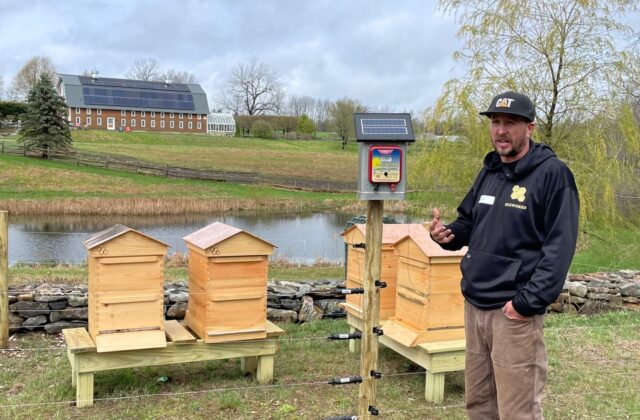The Buzz of Spring
Beekeeping in the Northwest Corner
By Avice Meehan
The moment has come to embrace the dandelions in your lawn and all those early flowering plants and trees that attract some of the 378 species of wild bees that call Connecticut home—in addition to the beloved, nonnative honeybee that brings such golden sweetness into our lives.
“If we can keep the insects doing well, the rest of the environment will take care of itself,” says commercial beekeeper Dan Watkins, who describes his approach as “If our bugs are good, we will be good.”
Watkins, who grew up in East Hartland, started keeping bees 11 years ago as a sideline to his work as an arborist in Connecticut and Massachusetts. That hobby has morphed into a full-blown business with his partner Erin Lass. Together, they run BeeWorks LLC and manage apiaries throughout Litchfield County, including at Husky Meadows Farm in Norfolk and Northwest Corner Farm in Winchester.
Working with landowners, Watkins takes the stress and frequent heartbreak out of managing honeybees by erecting a sturdy electric fence and providing purpose-built hives made from trees he’s cut, milled and dried. The bees are Italian honeybees that have either overwintered or traveled up from Georgia. Watkins monitors the health of the hives throughout the season and returns the honey that’s produced to the property owner.
“I’ve been working at creating a pollinator pathway, and I thought the next step would be to help them and help me,” says Norfolk’s Jen Pfaltz, who will have two BeeWorks hives on her Winchester Road property this year. “I like the whole idea of it because you can participate as much or as little as you want.”
These are challenging times to be a bee. In its most recent annual report, the Connecticut Agricultural Experiment Station reports that beekeepers across the region lose a high percentage of their colonies (more than 65 percent in 2021) over the course of a year. The primary cause is infestation by the Varroa mite, which entered the United States in the 1990s. It feeds on bees and also transmits viruses that weaken or kill them.
The federal Wild Bee Monitoring Program counts 378 species in Connecticut, but at least four, including the rusty-patched bumblebee, are considered of “special concern.” The yellow-banded bumble bee or Bombus terricola is listed as endangered in Connecticut, but “persisting populations” have been found in Norfolk, Goshen and Winsted.
“We should all be worried about pollinator loss, in general, and we should be planting habitat for pollinators,” said Dan Carr during his recent talk at the Norfolk Library. “I think of beekeeping as the gateway drug to becoming a naturalist.”
Carr and his wife Marleen van Gulick run Beavertides Farm in Falls Village and raise bees, as well as sheep, cattle and goats. Their popular 10-week Beekeeper Training Course (starting May 6) teaches everything from how to install a hive to harvesting honey. As a veteran beekeeper and educator, Carr has managed hives in both urban and rural settings. He noted that there’s nothing like caring for bees to focus one’s attention on habitat loss, pesticide use and the impact of extreme weather.
This is why Watkins and Lass also focus on pollinator land management and are certified by the Northeast Organic Farming Association. For DYIers, that can mean living with dandelions and clover and less frequent mowing, as well as finding ways to support the more solitary habits of native bees, many of which prefer to nest in the ground or in forested areas where snags (dead trees) have been left.
“Bees and humans have had a 10,000-year relationship,” says Watkins. “We are tied to these critters, and it’s neat to be a part of that relationship in a very natural way.”

